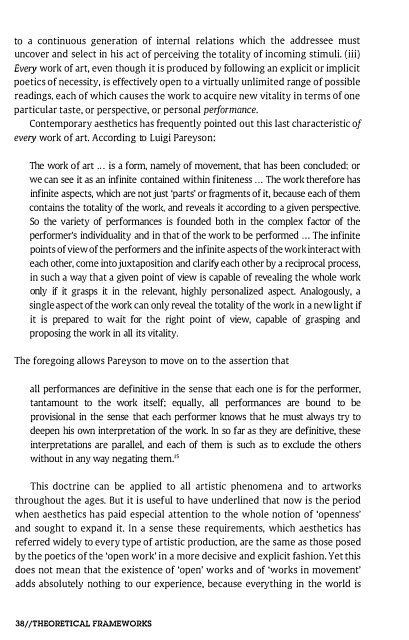Create successful ePaper yourself
Turn your PDF publications into a flip-book with our unique Google optimized e-Paper software.
to a continuous generation of internal relations which the addressee must<br />
uncover and select in his act of perceiving the totality of incoming stimuli. (iii)<br />
Every work of art, even though it is produced by following an explicit or implicit<br />
poetics of necessity, is effectively open to a virtually unlimited range of possible<br />
readings. each of which causes the work to acquire new vitality in terms of one<br />
particular taste, or perspective, or personal performance.<br />
Contemporary aesthetics has frequently pointed out this last characteristic of<br />
every work of art. According to Luigi Pareyson:<br />
The work of art ." is a form, namely of movement, that has been concluded; or<br />
we can see it as an infinite contained within finiteness ... The work therefore has<br />
infinite aspects, which are not just 'parts' or fragments of it, because each of them<br />
contains the totality of the work, and reveals it according to a given perspective.<br />
So the variety of performances is founded both in the complex factor of the<br />
performer's individuality and in that of the work to be performed ... The infinite<br />
points of view of the performers and the infinite aspects of the work interact with<br />
each other, come into juxtaposition and clarify each other by a reciprocal process,<br />
in such a way that a given point of view is capable of revealing the whole work<br />
only if it grasps it in the relevant, highly personalized aspect. Analogously, a<br />
single aspect of the work can only reveal the totality of the work in a new light if<br />
it is prepared to wait for the right point of view, capable of grasping and<br />
proposing the work in all its vitality.<br />
The foregoing allows Pareyson to move on to the assertion that<br />
all performances are definitive in the sense that each one is for the performer,<br />
tantamount to the work itself: equally, all performances are bound to be<br />
provisional in the sense that each performer knows that he must always try to<br />
deepen his own interpretation of the work. In so far as they are definitive, these<br />
interpretations are parallel, and each of them is such as to exclude the others<br />
without in any way negating them.!5<br />
This doctrine can be applied to all artistic phenomena and to artworks<br />
throughout the ages. But it is useful to have underlined that now is the period<br />
when aesthetics has paid especial attention to the whole notion of 'openness'<br />
and sought to expand it. In a sense these requirements, which aesthetics has<br />
referred widely to every type of artistic production, are the same as those posed<br />
by the poetics of the 'open work' in a more decisive and explicit fashion. Yet this<br />
does not mean that the existence of 'open' works and of 'works in movement'<br />
adds absolutely nothing to our experience, because everything in the world is<br />
38/ /THEORETlCAL FRAMEWORKS








